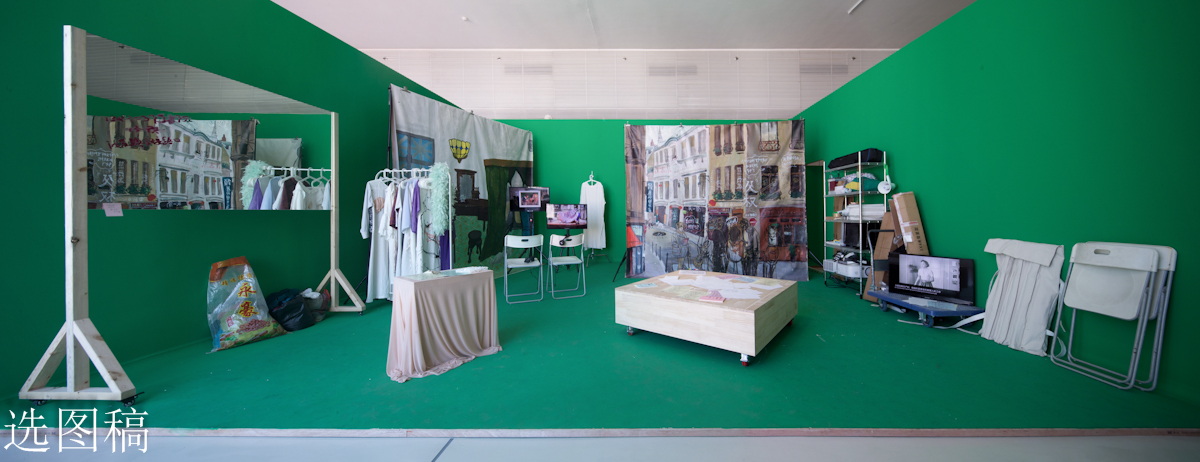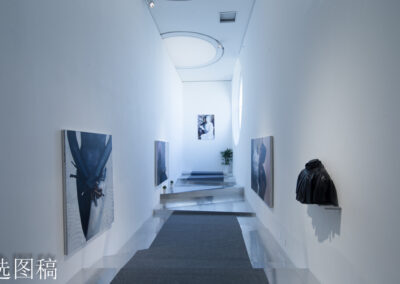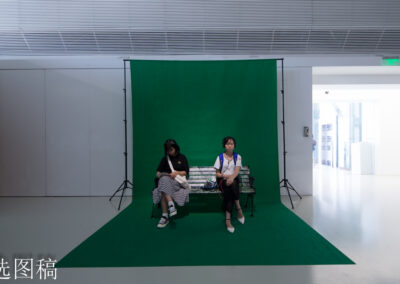Can an Institution Speak for a Woman?

CATEGORY
Accessibility | Diversity/ Inclusion | ParticipationYEAR
2017DURATION
9 monthsLOCATION
OnsiteFORMAT
research trip-exhibition-workshopWEBSITE
https://www.timesmuseum.org/en/program/pan-yuliang-a-journey-to-silenceTARGET
Audiences who recognize Pan Yuliang as a famous Chinese female artist emerged in the early 20th century but have little awareness of the patriarchal structure that has constructed the historical narratives of her life and the feminist struggles that have been taken by generations of woman artistsThe moment we embarked on the journey of investigating artist Pan Yuliang and her life, we found the prescribed mission of speaking for her impossible.
The largest collection of Pan Yuliang’s work is held in the Anhui Provincial Museum, which is currently under renovation and thus renders the permanent display of her selected works invisible. Upon our arrival at the museum, Pan Yuliang’s Pan Holding a Fan (1939) was put in front of us on a stretcher directly from the museum’s storage. The door of the elevator shut behind it with the sound of aged machinery, and the portrait silently entered the room full of people. Pan Yuliang was depicted in her signature dark-colored cheongsam, with her lips closed, the corners of her mouth down—she looked right at us without revealing much about her state of mind.
“So I arrive at the green door, I’m intrigued. I open it, and guess what? There is a whole party going on, a room full of people, conversations, connections that somehow haven’t made it into mainstream history.” When the London-based writer Sophie Hardach wrote about her fascination for one of Pan Yuliang’s portraits from the 1930s, in which the protagonist strikingly resembles Josephine Baker—the most famous artist in the black entertainment scene in Paris in the 1920s and 1930s—Hardach asked the same particular question as we do in relation to the portrait before us: Who is this woman?
Most of the academic essays about Pan Yuliang start with a few paragraphs that summarize her biography to contextualize the subject, and it is worth providing a lengthy quote here from one of many voices that have tried to speak about her.
Pan was born on 14 June 1895 in Yangzhou in Jiangsu province as Chen Xiuqing, and was renamed Zhang Yuliang when adopted by her uncle after the early passing of her parents. Her guardian sold her to a brothel in the city of Wuhu in Anhui province when she was in her early teens. Greatly empathizing with Yuliang’s desperate situation, Pan Zanhua (潘赞化,1885-1959), a customs official from Wuhu, redeemed her from the brothel… Shanghai Art Academy, under the bold leadership of its founder Liu Haishu (刘海粟, 1896-1994), took in its first batch of female students, including Pan, in 1918. The school’s vision of co-education was a response to the newly appointed Minister of Education in Republic China, Cai Yuanpei’s (蔡元培, 1868-1940) educational reforms…
With her excellent results at the academy, Pan became the first woman artist in the Chinese Republic to win an official scholarship to study in France… In 1922, Pan studied at the École des Beaux-Arts de Paris under the tutelage of French artists Lucien Simon (1961-1945) and Pascal-Adolphe-Jean Dagnan-Bouveret (1852-1929)… When Pan graduated from the École in Paris in 1925, she was awarded the prestigious Rome Scholarship at the Accademia di Belle Arti in Rome. In 1928, the year that she returned to China, Pan held her first solo exhibition in Shanghai with the title China’s First Female Western Artist… In 1931, Pan decided to accept artist Xu Beihong’s (徐悲鸿, 1895-1953) invitation to teach full-time at the art department of the National Central University in Nanking… Yu Feng (郁风, 1916-2003), a prominent woman artist who studied under Pan in the 1930s, defended her, “As a highly innovative artist, Pan has every reason to be ranked with her male counterparts, including Xu Beihong and Liu Haisu”
After departing for Paris in 1937, Pan participated in numerous group exhibitions and held solo ones in various countries, including France, England, Belgium and the United States… Strange as it seems, while she was well-regarded in the French art community, it is her few sculptures rather than her paintings that make up the bulk of her works that are now kept in France. Pan’s Bust of Zhang Daqian (1957), kept by the Musée d’Art Moderne de Ville de Paris, could be considered a timely memorial work for the museum because Zhang(张大千),Pan’s teacher and an old friend, had just held a solo exhibition at the Musée d’Art Moderne de la Ville de Paris in1956…
One cannot help but notice that regardless of the proliferation of scholarship on Pan Yuliang in the past few decades, historical narratives of Pan Yuliang and her life are overwhelmingly marked by names of her male counterparts. The only female voice was that of her student Yu Feng, which stood out as notably defensive. It is as if without this constellation of male figures there is no way to map Pan Yuliang’s world. The social network of Pan Yuliang’s early career as a modernist artist and an art educator in the period of the Republic of China resonated with larger social-political movements at that time: from the cultural construct of ‘New Woman’ and the New Culture Movement, to the revolution and reform launched by the Nationalist Party and early Communists and the rise of modern nationalism in China, and from the end of World War I to the Japanese Invasion in 1937. While many of her male peers and acquaintances advocated their social, political, and cultural visions in public, and made their way into mainstream history, Pan Yuliang’s own accounts related to major decisions on changes in her life and her artistic motivation are nowhere to be found. The silent journey continued beyond her return to Paris in 1937, and “Pan Yuliang did not leave any written commentary regarding her concept for the show,” titled Quatre artistes chinoises contemporaines, which opened on March 26 and ended April 30, 1977 in Musée Cernuschi in Paris. A few months later, Pan Yuliang passed away and left behind a few thousand works, which were transported to the basement of the Chinese Embassy in Paris, and temporarily stored there until they were sent back to China in 1984. Since then, the self-portrait Pan Holding a Fan (1939) has resided in the Anhui Provincial Museum, reappearing before us in 2017.
Besides academic research from the perspectives of art history, gender studies, and transnational cultural studies, a ‘Pan Yuliang fever’ has also emerged in pop culture and mass media since the 1990s. According to a book review about Jennifer Cody Epstein’s novel A Painter from Shanghai, in The New York Times on March 23, 2008, Pan Yuliang was “a former child prostitute turned celebrated painter,” and “Yuliang was sold into sexual slavery at 14 by her opium addicted uncle.” Epstein’s novel also made Hrag Vartanian, the Editor-in-chief and co-founder of Hyperallergic, so interested in the character of Pan Yuliang that he wrote a blog entry, “From Prostitute to Post-Impressionist: China’s Modern Art Ambassador,” on April 30, 2008, to express his curiosity about her legendary life. A similar headline had been adopted by China Daily back in 2002, where Pan Yuliang’s extraordinary trajectory was summarized as “From red lights to painting the town red.”
The more articles and reviews picture Pan Yuliang as an oriental Cinderella, the further we drift away from her real efforts and struggles. Here we are locked down again “in a whole party going on, a room full of people, conversations, connections…” as Hardach described it metaphorically. On the one hand, we were granted limited access to only a few of her works among the 4,749 pieces in the collection of the Anhui Provincial Museum. As a state-funded museum, the Anhui Provincial Museum is responsible for organizing touring exhibitions of their Pan Yuliang collection, which only circulates within the state system. On the other hand, search results on the Internet about Pan Yuliang turn out to be inexhaustible, while academic writings repeat the same chronology again and again, but offer few new insights about her life and her artistic value. It is as if the portrait of Pan Yuliang is turned against our gaze, and has sunk back into the vaults when the elevator door closed, withdrawing to her ghost-like existence. We met with Dong Song, whose father was directly involved in organizing Pan Yuliang’s works when they were delivered back from France in 1984, and who himself is currently director of exhibitions in the Anhui Provincial Museum, and the author of Pan Yuliang Artistic Chronology, published in October 2013. Our discussions about Pan Yuliang’s last 40 years in Paris, and the absence of her own artistic statements concluded with a certain consensus. We all agreed that because of Pan Yuliang’s lower origins and the lack of education in the earlier years of her life, she had never acquired the competence to write about her own artistic ideas and practice. She devoted her last 40 years to painting, in a relatively secluded and nostalgic mode. She might have had a chance to go back to China after World War II, but something stopped her. We speculated that she had provided the only financial means to support Pan Zanhua, and his whole family, throughout the years of the Great Famine in the 1960s until the end of Cultural Revolution. Most of her writing consists of private letters between her and her family, and revolved around issues such as health, money, children, and her early encounters with Pan Zanhua. Xu Beihong, Liu Haisu, and Zao Wou-Ki all came from privileged backgrounds, and the last of whom “loved to quote French expressions directly, sometimes without translation, in his critical texts and even in the inscriptions adorning his drawings.” In contrast, Pan Yuliang, an orphan, a woman, and Chinese, faced the situation of double othering and silencing. There is no better way to describe this revelation than when Gayatri Chakravorty Spivak cites Pierre Macherey in her acclaimed essay “Can the Subaltern Speak?”
What is important in a work is what it does not say. This is not the same as the careless notation ‘what it refuses to say,’ although that would in itself be interesting; a method might be built on it, with the task of measuring the silences, whether acknowledged or unacknowledged. But rather this, what the work cannot say is important, because there the elaboration of the utterance is carried out, in a sort of journey to silence.
In 1975, Pan Yuliang was invited by the museum curator Vadime Elisséeff to hold a solo exhibition according to the wish of the late René Grousset (1885-1952), curator of the Musée Cernuschi from 1932 until 1952. Instead of just presenting her own works, Pan Yuliang extended the invitation to include three other woman artists, who worked in traditional art forms and were all part of the Chinese diaspora, as Anik Fournier has outlined in her essay on the exhibition. Looking back at exhibition history from a global perspective, Quatre artistes chinoises contemporaines opened in Musée Cernuschi in Paris in 1977, and was one of the earliest to present only female artists. Forty years later, as curator of Guangdong Times Museum, I was invited by Mélanie Bouteloup and Villa Vassilieff to present a research-oriented project about Chinese artists in the Marc Vaux Archive, in which glass-plate photographs of Pan Yuliang working in her studio were found. Inspired by Pan Yuliang and her decision to expand the exhibition of 1977 to others, I invited artist Hu Yun, Huang Jing Yuan, Wang Zhibo, and art historian Mia Yu to form a research group functioning as a collective subjective agency. Departing from the idea of representing Pan Yuliang by claiming new territories of authority, or the delusion of bringing justice to her misrepresentation in the mass media, we displaced our own subjectivities in the constellation of Pan Yuliang’s past life, and her incarnation in our time as well as in the current exhibition. The following materials were are all treated as equal sources and as objects for investigation and presentation: art historical papers and essays of gender and cultural studies; articles and reviews from China Daily and The New York Times, and archival clippings of newspaper reviews in the 1920s and 1930s; catalogues published by the National Museum of China and the Anhui Provincial Museum; discussions and interviews with researchers and scholars specializing in Pan Yuliang, and the representation of women in the Republic of China; websites, blogs, and exhibitions dedicated to Pan Yuliang; novels, TV dramas, documentaries, and films about Pan Yuliang and similar female artists; original pieces, printed matter, and digital copies of Pan Yuliang’s works; and our own research notes, conversations and trajectories.
Spivak was right in suggesting that “the archival, historiographic, disciplinary-critical and, inevitably, interventionist work involved here is indeed a task of ‘measuring the silences.’” Both as object of phallocentric and ideological construction and as subject of modern emancipation, Pan Yuliang is inevitably marked as the Other in her country of origin as well as in Europe. Is it possible to address ourselves to another layer of narratives that do not consolidate Pan Yuliang’s position as the Other? Can we find the otherness in ourselves by projecting onto Pan Yuliang’s struggles? And further, can we retrace Pan Yuliang’s path by crossing it in our own?
As an art historian who attempts to blend her research with an artistic voice, Mia Yu created an archive-based project titled An Art Historian’s Studio: Entangled Paths (2017). After immersing herself in the archival material and historical writings about Pan Yuliang, Mia Yu set out on a journey to trace Pan Yuliang’s life in China. By physically situating herself at a series of historical sites, and engaging in intense conversations with the people she met on her journey, Mia Yu not only re-imagined the past through personal experiences, but also constantly intersected history with contemporary reality. In the exhibition, Mia Yu presents a multi-layered archive, comprising of archival materials, personal notes, photos, journal entries, and records of private discussions. Popping up throughout the exhibition space, the clusters of archive intertwine with other works and simultaneously invite other artists’ interventions.
In the meantime, Wang Zhibo, a painter whose educational background in academic realism at the China Academy of Art in Hangzhou can be dated back to the 1920s and 1930s, when Pan Yuliang and her male peers laid the foundation of the modern art education system in China, is now ready to move on to her new studio in Berlin while working on the exhibition in Villa Vassilieff in Paris. Wang is intrigued by the Parisian moments of Pan Yuliang’s seemingly traditional life and self-portraits as a Chinese woman. By making new paintings based on Pan Yuliang, and setting up a woman painter’s studio in Villa Vassilieff, she creates a detour of Her (2017) between Pan Yuliang and a Chinese woman born almost a century later.
In Huang Jing Yuan’s video and installation Unkind Jade: Three Chinese Painters (2017), her own path as a visual artist and woman is reflected upon by subjective narratives of her father, who failed his own dream of becoming an artist due to the Cultural Revolution, but held on to the doubts of women’s struggle for artistic autonomy. The interfering images and sounds from TV programs and soap operas are presented as circumstantial evidence in the everyday life of an ordinary Chinese who has difficulty speaking from her own precarious subjectivity. The subtle disappointment and tension within the family resonate with the ubiquitous obstacles that women encounter while pursuing their artistic passion.
Hu Yun, a young father who was born in the French Concession in Shanghai 50 years after Pan Yuliang’s second departure from Shanghai, is invited to further develop his artistic research on the institutionalization and ideals of modernity introduced by European missionaries or Chinese intellectuals that have been overshadowed in mainstream history. Besides presenting his own work, Hu‘s Autoportrait (2017) incorporates elements of life and artistic practice of Chinese artists and intellectuals who lived in Paris through different periods, intervening in the setup of Mia Yu’s chronology or installations by Wang Zhibo and Huang Jing Yuan.
Defying the usual autonomous area of individual work and artist, all of the participants in the exhibition are hosts as well as guests of each other’s contributions. The research and the exhibition form a polyphonic orchestra that not only echoes Pan Yuliang’s unique trajectory between modern and traditional China, but also situates her constructed biography and artistic achievement within contemporary motives, detours, and universe. After the presentation in Villa Vassilieff, the journey will unfold into its second stage in the Guangdong Times Museum, where more artists are invited to join the conversation, and develop new interrogations that arise from Pan Yuliang while responding to the current situation of woman and female artists in China.
So, what haven’t we said about Pan Yuliang in this room?
LINKS
FILES
AUDIO





